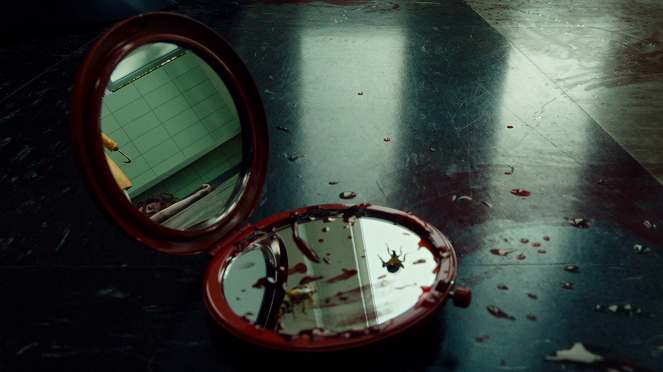Directed by:
Nia DaCostaCinematography:
John GuleserianComposer:
Robert Aiki Aubrey LoweCast:
Yahya Abdul-Mateen II, Teyonah Parris, Nathan Stewart-Jarrett, Colman Domingo, Kyle Kaminsky, Tony Todd, Vanessa Williams, Miriam Moss (more)VOD (2)
Plots(1)
For as long as residents can remember, the housing projects of Chicago's Cabrini-Green neighborhood were terrorized by a ghost story about a supernatural killer with a hook for a hand, easily summoned by those daring to repeat his name five times into a mirror. In present day, visual artist Anthony McCoy and his partner, gallery director Brianna Cartwright, move into a luxury loft condo in Cabrini, now gentrified beyond recognition. A chance encounter with a Cabrini-Green old-timer exposes Anthony to the tragically horrific nature of the true story behind Candyman. Anthony begins to explore these macabre details, unknowingly opening a door to a complex past that unravels his own sanity and unleashes a terrifying wave of violence that puts him on a collision course with destiny. (HBO Max)
(more)Videos (4)
Reviews (6)
I won't rate how much it reflects current social discourse and how much of a "black" movie it is. I'll leave that to the more conscious. Of course, the nostalgia and 90s retro atmosphere are gone, yet in some ways this (almost pure) sequel to the original 1992 film is remarkable and very much above average in the "modern mainstream horror" category. Knowledge of the original film is more or less required, otherwise you'll miss the non-trivial connections. [65%]
()
A surprisingly meaningful follow-up to the original film from the 1990s and a timely update for today. It can be uncomfortable and disturbing without explicitly showing violence (which, by the way, neither did the original film). At the same time, it can be beautiful and aesthetic (the film is playfully shot to make use of various mirror reflections, etc.) even though it deals with ugly things. We probably haven’t seen better craftsmanship in the horror field this year.
()
Candyman is an admirably directed and scripted film in the current horror context, with two great talents – DaCosta and Peele – supporting each other, taking turns to carry the weight where the other falters. As a result, the film can never be completely condemned in any of its parameters (unless you're a complete cretin, see below). Thus, the new Candyman isn't offering a white-guilt pose – the protagonist is a gentrified African-American trying to exploit his socio-cultural background. The episodic nature of the white characters (where the snobbish art critic figures thus belong somewhere three decades earlier) can then be justified by the fact that it's simply not about them this time. Their exclusion then allows for a stronger coalescence around the former ghetto and the people tied to it, where the horror is not the sudden appearance of the Candyman but his omnipresence. The shot of the killer slowly leaning out from behind the door in the background is more terrifying than fifty thousand jump scares at once. Jordan Peele proves once again his excellence as a screenwriter, because he's a step further than the rest with stories about the legacy of oppression (as literal and tendentious as the ending already is), and he's able to explore, connect, and paraphrase in genre form African-American trauma, and I think that's just great. And DaCosta has a sense for working with space and narrative images. I'd quite like to see them stay together. And maybe get some better actors this time around.
()
This movie is pretentious nonsense. The original Candyman worked great on its own as a horror film, but this reboot does not work at all. You could only dream of some atmosphere and feeling of apprehension for the characters. The only scenes worth mentioning are that much-vaunted distant and retreating footage of a murder in progress and similar visual ideas. However, the whole thing falls apart in its attempt to follow the mythology of the original movie (including a completely random and confusing cameo by Tony Todd) and in its insanely literal attempts at some sort of critical social commentary.
()
The most recent instalment of the series is a solid recycling of the original Candyman myth for today, which comes across as appealing and literal, not only in comparison with the phenomenal and, in terms of the genre, very atypical original. The classic slowly gnawed away the foundations of reality and rationality, and worked dramaturgically with a view from outside that, at the same time, problematised and thoughtfully thematised, developed and analysed the phenomenon of urban legends until it became one itself. Conversely, the new Candyman relies on the contemporary formula of combining spectacular brutality and ostentatious cleverness. The screenplay highlights the motif of names and their importance to the narrative, as well as the identity and iconography of the community in a thought-provoking way. The narrative itself is built around the pain and trauma of African-Americans as individuals and as a community, thanks to which it strongly resonates with issues that have been a long-lived experience for them and have been brought to the attention of the rest of the world by the protests and, especially, the discussions following the killings of Breonna Taylor and George Floyd. The film thus abandons a more general overlap, but it does so at the cost of expressive emancipation. As a character, the Candyman thus becomes an amalgam of names, faces, injustices and pain. The view from the inside may not allow him to take flight like the original did but, on the other hand, it gives him the power of eloquence.
()
Gallery (30)
Photo © Metro-Goldwyn-Mayer (MGM)



Ads